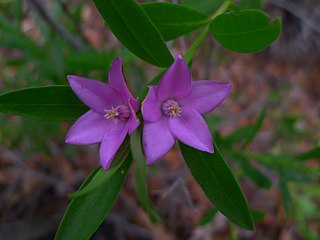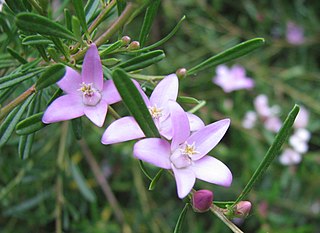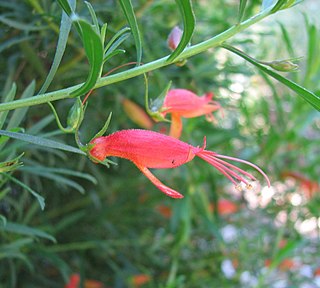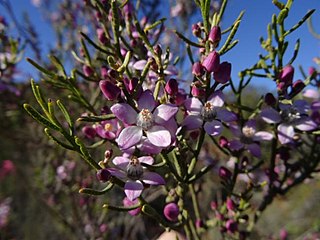
Crowea saligna, commonly known as willow-leaved crowea, is a plant in the rue family, Rutaceae and is endemic to eastern New South Wales in Australia. It is a small shrub with attractive, pink, star-shaped flowers and is commonly cultivated.

Crowea is a genus of small evergreen shrubs in the family Rutaceae, sometimes known as waxflowers. There are three species and many subspecies and cultivars, all of which are popular as ornamentals because of their abundant, attractive flowers which often occur during autumn and winter. Crowea species are all endemic to Australia, where they occur in Victoria, New South Wales and Western Australia.

Calothamnus quadrifidus, commonly known as one-sided bottlebrush, is a plant in the myrtle family, Myrtaceae and is endemic to the south-west of Western Australia. The common name alludes to the arrangement of the flowers in the inflorescence which line up on one side of the stem. It is a shrub with grey-green, pine-like foliage covered with soft hairs and red, four-part flowers in spring. Widely cultivated because of its attractive foliage, colourful, unusual and prolific flowers, it grows in a variety of habitats and soils. In 2010, Alex George published a review of the species based on recent research and described a number of new subspecies.

Eremophila maculata, also known as spotted emu bush or spotted fuchsia-bush, is a plant in the figwort family Scrophulariaceae, and is endemic to Australia. It is the most widespread of its genus in nature and probably the most frequently cultivated Eremophila. It is a spreading, often densely branched shrub with variable leaf shape and flower colour, but the other features of the flowers such as the size and shape of the parts are consistent. The inside of the flower is often, but not always, spotted.

Eremophila decipiens, commonly known as slender fuchsia bush or narrow-leaved fuchsia bush is a flowering plant in the figwort family, Scrophulariaceae and is endemic to an area extending from the south-west of Western Australia to southern parts of South Australia. It is low, sprawling shrub with lance-shaped leaves and red, orange or yellow flowers on a long, S-shaped stalk.

Eremophila fraseri, commonly known as burra or jilarnu, is a flowering plant in the figwort family, Scrophulariaceae and is endemic to Western Australia. It is a shrub or small tree with all above-ground parts of the plant, apart from the petals, sticky and shiny due to the presence of a large amount of resin. The petals are coloured white, cream, pink and brown.

Phebalium squamulosum , commonly known as scaly phebalium or forest phebalium, is a species of shrub or slender tree that is endemic to eastern Australia. It has smooth branches covered with rust-coloured scales, linear to elliptical or egg-shaped leaves with the narrower end towards the base, and pale to bright yellow flowers in umbels with rust-coloured or silvery scales on the back.

Melaleuca fulgens, commonly known as the scarlet honey myrtle, is a plant in the myrtle family Myrtaceae, and is endemic to Western Australia, South Australia and the Northern Territory. It is notable for its showy orange, red or purple flowers, unusual foliage and fruit, and is a popular garden plant. It is a member of Melaleuca, a large and diverse genus whose members range from large trees such as M. quinquenervia, to small shrubs.

Philotheca salsolifolia is a species of flowering plant in the family Rutaceae and is endemic to New South Wales and the Australian Capital Territory. It is a shrub with crowded, more or less cylindrical leaves and pink to mauve flowers with a dark central stripe and arranged singly or in twos or threes on the ends of branchlets.

Asterolasia asteriscophora, commonly known as lemon starbush, is a species of slender, erect shrub in the family Rutaceae and is endemic to southern continental Australia. It has woolly, star-shaped hairs on its young branches, variably-shaped leaves covered with brownish or whitish hairs on the underside, and yellow flowers with woolly brown, star-shaped hairs on the back.

Crowea angustifolia is a flowering plant in the family Rutaceae, and is endemic to the south-west of Western Australia. It is an erect shrub growing to 3 m (10 ft) high by 1.0 m (3 ft) in diameter with white or pink flowers in spring.

Boronia deanei, commonly known as Deane's boronia, is a plant in the citrus family Rutaceae and is endemic to the central and southern highlands of New South Wales. It is an erect shrub with crowded, strongly aromatic leaves and white to bright pink flowers in late winter and spring.

Philotheca angustifolia, commonly known as narrow-leaf wax flower, is a species of flowering plant in the family Rutaceae and is endemic to south-eastern Australia. It is a shrub with small leaves and white flowers with five egg-shaped petals in spring.

Philotheca brucei is a species of flowering plant in the family Rutaceae and is endemic to Western Australia. It is a shrub with cylindrical leaves grooved along the top and in spring, white to pink or mauve flowers with five egg-shaped petals.
Phebalium brevifolium is a species of small shrub that is endemic to Western Australia. It has warty branchlets, sessile, wedge-shaped leaves and up to three white flowers arranged in umbels.

Phebalium longifolium is a species of shrub that is endemic to far north Queensland. It is more or less covered with silvery to rust-coloured scales and has smooth branchlets, narrow elliptical to narrow lance-shaped leaves and cream-coloured flowers in umbels on the ends of branchlets. It grows in the boundary between forest and rainforest in tropical areas.

Phebalium verrucosum is a species of shrub that is endemic to New South Wales. It has branchlets densely covered with white scales, narrow elliptic, oblong or linear leaves covered with white scales on the lower side, and umbels of creamy white flowers with silvery or rust-coloured scales on the back of the petals.

Philotheca epilosa is a species of flowering plant in the family Rutaceae and is endemic to eastern Australia. It is a shrub with egg-shaped to lance-shaped leaves with the narrower end toward the base and crowded near the ends of the glandular-warty branchlets, and white flowers usually arranged singly on the ends of the branchlets.

Philotheca gardneri is a species of flowering plant in the family Rutaceae and is endemic to the south-west of Western Australia. It is a shrub with crowded, narrow club-shaped or more or less spherical leaves and white flowers with a prominent pink midrib, usually borne singly on the ends of branchlets.

Philotheca scabra is a species of flowering plant in the family Rutaceae and is endemic to New South Wales. It is a small shrub with variably shaped leaves, depending on subspecies, and single white to pink flowers arranged on the ends of branchlets.



















